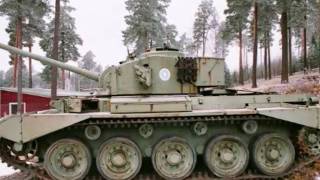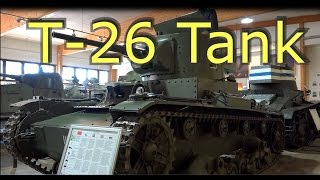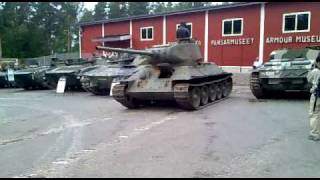Thursday, 25 December, 2025г.
















Где искать: по сайтам Запорожской области, статьи, видео ролики
пример: покупка автомобиля в Запорожье
Armour Museum Combat Show 2018 #2 - The Full 1st Show - Parola Kevätsawutus 1.5.2018
Combat show, the first show of the day. All vehicles on the move.
1.5.2018 Kevätsawutus Panssarimuseo / Parola Armour Museum’s Engine Warming Day activities.
Vappu / May Day 2018, 1st of May, is the annual activity day of the museum, the "mini tankfest", when the museum drives out some of the vehicles and gives the audience a nice show.
Combat / action show vehicles:
BTR-50 PUM
ZSU-57-2
T-34-85
Tankspotting (TV) is dedicated for the heavy metal battlefield. If you enjoy tanks and other awesome things then please subscribe - just click here:
https://www.youtube.com/user/Tankspotting?sub_confirmation=1
Video/editing: Jukka O. Kauppinen
(C) Tankspotting / Mediapalvelut 2019
http://www.mediapalvelut.fi
BTR-50PUM
The BTR-50 (BTR stands for Bronetransporter (БТР, Бронетранспортер), literally "armored transporter") is a Soviet amphibious armored personnel carrier (APC) based on the PT-76 light tank. The BTR-50 is tracked, unlike most in the BTR series, which are wheeled.
The BTR-50 was developed in 1952 and entered service with the Soviet Army in 1954. It was first shown in public in November 1957. It served in the motorized rifle regiments of tank divisions and mechanized brigades in the Soviet and East German armies.[1] A typical mechanized brigade consisted of three battalions, each of which had 30 APCs and a command vehicle. They were replaced in front line service by the BMP-1 IFV.
BTR-50PUM is Finnish varianet, upgraded BTR-50PU fitted with the equipment of the R-145BM (BTR-60 variant) and smoke grenade launchers, one NSVT 12.7 mm heavy machine gun and additional armor.
BTR-50PUM1 is Finnish variant, modernized PUM with western radio sets.
ZSU-57-2
The ZSU-57-2 Ob'yekt 500 is a Soviet self-propelled anti-aircraft gun (SPAAG), armed with two 57 mm autocannons. 'ZSU' stands for Zenitnaya Samokhodnaya Ustanovka (Russian: Зенитная Самоходная Установка), meaning "anti-aircraft self-propelled mount", '57' stands for the bore of the armament in millimetres and '2' stands for the number of gun barrels. It was the first Soviet mass-produced tracked SPAAG. In the USSR it had the unofficial nickname "Sparka", meaning "twin mount", referring to the twin autocannon with which the vehicle is armed.
Based on past experiences with SPAAG designs, Soviet engineers designed a vehicle that used a modified T-54 chassis, with four twin road wheels per side instead of five, and much thinner armour. The vehicle was armed with twin 57 mm S-68 autocannon in a new, large, rotating, open-topped turret. The ZSU-57-2 consists of three compartments: driver's in the front, fighting in the middle and engine-transmission at the rear. The hull is more spacious in comparison with the T-54 because of the thinner armour and has different locations for some equipment. The general layout, with transverse mounting of the engine, is the same.
The twin S-68s are recoil-operated and weigh 4,500 kg. Their construction was based on two 57 mm S-60 AA autocannons. The guns have a recoil of between 325 and 370 mm. The individual weapons cannot be swapped from one side to the other as they are mirror images. Each air-cooled gun barrel is 4365 mm long (76.6 calibers) and is fitted with a muzzle brake.
The guns firing together are capable of firing up to 210–240 fragmentation and armour-piercing tracer (AP-T) shells per minute, with a practical rate of fire of between 100 and 140 rounds per minute.
T-34-85
Introduced in 1944 as a counter to the German Panther and Tiger 1, the T-34/85 was one of the best tanks to fight in World War II. Nearly 50,000 were built between 1944 and 1958 and it was produced in larger numbers than any other World War II tank.
The T34-85 mounted an S-53 85mm gun carried in a three-man turret.
Finnish use: Seven tanks were taken to Finnish use during Continuation War. First T-34/76 was taken to Finnish use in October of 1941. The last of these tanks remained in Finnish use until year 1961. The tanks were both captured in combat and brought from Germany.
Parola Armour Museum
Parola Tank Museum, Armoured Vehicle Museum is a military museum located 110 kilometres north of Helsinki in Parola, near Hämeenlinna, Finland, a few kilometres from the Finnish Army Armoured Brigade training unit. It displays various tanks, armoured vehicles and anti-tank guns used by the Finnish Defence Forces throughout their history. A rare exhibit is an armoured train used in World War II. The museum was opened on June 18, 1961, when there were 19 tanks and 12 anti-tank guns on display.
--
Thanks so much for watching. Wouldn't it be nice if you subsribed us also? You can do it easily here:
https://www.youtube.com/user/Tankspotting?sub_confirmation=1
For more information please see:
Tankspotting: https://www.youtube.com/user/Tankspotting
Facebook: https://www.facebook.com/tankspottingtv
Twitter: https://twitter.com/tankspottingtv
Теги:
Tankspotting tanks tank armor armour vehicles war combat history tankit tankki panssarit panssarivaunut spotting sota sotahistoria suomi finland panssarimuseo parola armour museum parola armour museum tank museum puolustusvoimat maavoimat armeija suomen armeija finnish army ground forces finnish defence forces t34 t-34 zsu btr kevätsawutus action day combat show
Похожие видео
Мой аккаунт


 У вашего броузера проблема в совместимости с HTML5
У вашего броузера проблема в совместимости с HTML5


